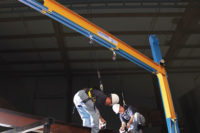
How long did you wear your last pair of safety gloves before changing to a new pair? Now ask a coworker this same question. Chances are you may each have different answers. The reason: glove durability.
In a recent study, respondents ranked durability as the third most important factor influencing glove choice while quality was rated the highest. Respondents were then asked, “What do you mean by quality?” Durability was the number one answer.
Can you define durability?
Glove durability generally relates to a glove’s longevity - its wear life up to the point at which the worker considers the product no longer suitable for the tasks at hand or “worn out.” Glove durability is difficult to measure since there are no objective tests or standards. Instead, a product’s wear life is often determined by the specific applications in which it is used. Safety directors and others who select gloves typically look at measurable performance characteristics such as cut protection, abrasion or chemical resistance and seldom consider durability and how it relates to injury prevention, overall productivity and costs.
Wear life is often subjective
For years the glove manufacturing industry has relied on tests such as ASTM F1790 to establish product standards and determine the specific levels and types of protection gloves provide. Unfortunately, similar tests and standards do not exist to measure durability. In their absence, glove replacement decisions often fall upon the workers who wear the products. These individuals frequently determine when a product is no longer serviceable.
How do workers determine when a product has reached this point? Visual perceptions tend to play a major role in product replacement decisions. Workers often rely on color variations between the coating and liner, with some workers disposing of their gloves as soon as the coating wears through. Is this the right decision - does the glove no longer “protect” when the coating wears out? Is this a safety or productivity issue at this point - or both?
Some workers may choose to discard their gloves when they are full of holes or the surface has abraded away. Again, product wear life will probably depend on the application. Without measurable characteristics, specific work standards or product training, workers are left to make product wear life decisions on their own.
The importance of training
Because durability is often an unfamiliar topic, workers should be trained about glove serviceability features, the applications in which specific products will be used and their impact on job performance. Workers should learn to identify the signs of wear and be able to recognize when their gloves no longer provide the right protection for the tasks they perform.
Training and education will be especially important as glove manufacturers develop new fabrics and technologies that increase product wear. Workers are likely to initially express skepticism about a glove that weighs half as much as the product they wore in the past yet offers a service life that is twice as long.
Studies confirm that workers are more likely to wear gloves when the gloves are comfortable and the worker understands the product’s purpose and use for specific applications. Training should be offered for cross-plant education and best practices implementation and should be a continuous process administered to all new employees and those involved with product and process changes. Instituting an ongoing training program will help reduce operational risks for employees and the overall organization.
Technology can extend wear life
Gloves with unbound layers are sometimes considered more durable than gloves with layers that are bound together. Unbound layers allow energy to be absorbed and dissipated as the layers move, thus contributing to longer glove life.
Materials with bound layers cannot move freely. This can be observed in gloves with a knit fabric and polymer coating. If the components are securely bonded, they can no longer move independently of each other, and this can diminish the product’s durability. Conversely, a multi layer construction that incorporates a very flexible agent may exhibit greater durability. The key element is the structure’s ability to resist (likely less durable) or absorb (likely more durable) the forces applied during use.
While fibers such as Kevlar®, Spectra® and Dyneema® are very strong, a quality associated with durability, researchers continue to develop new polymers and technologies that increase durability. In addition, glove manufacturers are examining existing materials and current manufacturing techniques to determine how they might be altered to increase product serviceability. They are also considering how they can modify existing yarns, polymers and treatments to optimize product usefulness and longevity.
Testing for durability
Besides education, the glove manufacturing industry needs to develop tests and standards to measure and predict durability. Glove durability should be evaluated in terms of the applications in which specific products will be used.
Durability should also be considered in terms of workers’ desire to continue wearing a certain glove after a period of time. Do they want to continue wearing gloves that appear intact but have lost or severely diminished one of their key performance characteristics? As an example, a well-worn, cut-resistant glove may provide only 75 percent of its original CPPT. Will this level of protection be enough to keep the worker safe while performing specific tasks?
In the future, many glove manufacturers will likely rely on third parties such as universities and independent laboratories to validate product durability. Test results - along with customer feedback - will help verify that the methods employed replicate real life situations and applications, helping to ensure glove durability and worker safety, factors that can positively impact a company’s bottom line.

